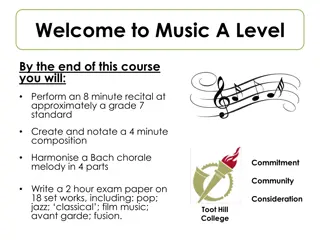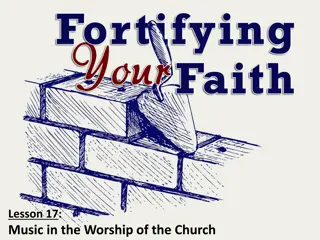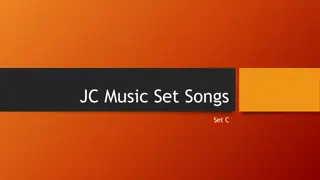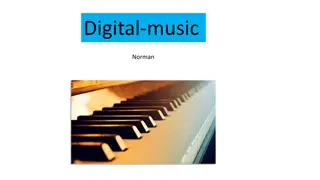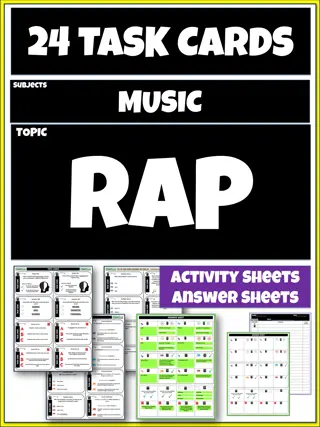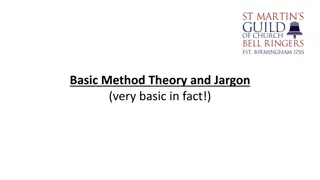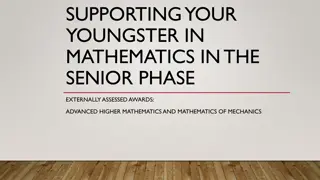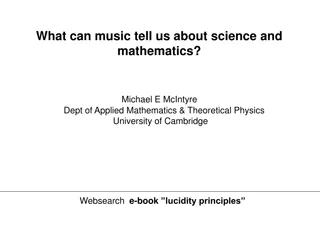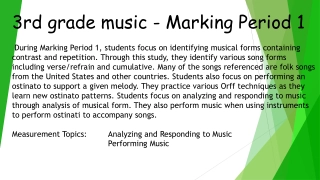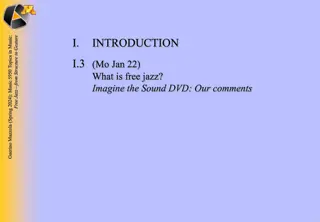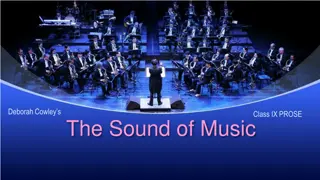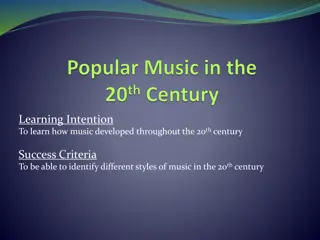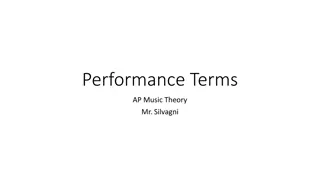Applying Mathematics to Music Composition: Part 1
Exploring the relationship between mathematics and music composition, this article challenges the limitations of Western Music Theory and delves into the mathematical foundations of intervals in music. By considering each element mod 12, the article discusses the space between pitches and different types of intervals, showcasing how mathematics serves as a universal language in music creation.
Download Presentation

Please find below an Image/Link to download the presentation.
The content on the website is provided AS IS for your information and personal use only. It may not be sold, licensed, or shared on other websites without obtaining consent from the author. Download presentation by click this link. If you encounter any issues during the download, it is possible that the publisher has removed the file from their server.
E N D
Presentation Transcript
Music Mathematics Mathematics The Universal Language Applying Mathematics to Music Composition: Part 1
To preface... Western Music Theory does NOT represent all facets of music. In fact, all of the rules established by Western Music Theory are often broken even in Western composition. This is merely what I have the most experience studying, and it also provides a relatively simple introduction to music and application to mathematics. 3
To preface... Western Music Theory does NOT represent all facets of music. In fact, all of the rules established by Western Music Theory are often broken even in Western composition. Music Theory is not something you learn in a day (or rather, in a 30 minute presentation). There is a reason people spend years studying music theory and composition. In order to examine the mathematical applications to this topic, we will not be delving into all of the reasoning behind the music theory. This is merely what I have the most experience studying, and it also provides a relatively simple introduction to music and application to mathematics. 4
C C#/Db D D#/Eb E F F#/Gb G G#/Ab A A#/Bb B 6
{C, C#/Db, D, D#/Eb, E, F, F#/Gb, G, G#/Ab, A, A#/Bb, B} 7
-36 -24 -12 0 12 24 36 48 {C, C#/Db, D, D#/Eb, E, F, F#/Gb, G, G#/Ab, A, A#/Bb, B} C 0 C#/Db 1 F 5 D 2 D#/Eb 3 E 4 F#/Gb 6 10 G 7 G#/Ab 8 A 9 A#/Bb B 11 {0, 1, 2, 3, 4, 5, 6, 7, 8, 9, 10, 11}, and consider each element (mod12) 8
C C#/Db D D#/Eb E F F#/Gb G G#/Ab A A#/Bb B 0 1 2 3 4 5 6 7 8 9 10 11 9
C C#/Db D D#/Eb E F F#/Gb G G#/Ab A A#/Bb B 0 1 2 3 4 5 6 7 8 9 10 11 Intervals: The space between each pitch 10
C C#/Db D D#/Eb E F F#/Gb G G#/Ab A A#/Bb B 0 1 2 3 4 5 6 7 8 9 10 11 Intervals: The space between each pitch minor 2 1 Perfect 5 7 Major 2 2 minor 6 8 minor 3 3 Major 6 9 Major 3 4 minor 7 10 Perfect 4 5 Major 7 11 Tritone 6 Perfect 8 12 11
C C#/Db D D#/Eb E F F#/Gb G G#/Ab A A#/Bb B 0 1 2 3 4 5 6 7 8 9 10 11 Intervals: The space between each pitch minor 2 1 Perfect 5 7 A Major 2 above C: (0+2)(mod12)= 2(mod12) 2 (D) Major 2 2 minor 6 8 A Major 3 above G: (7+4)(mod12) = 11(mod12) 11 (B) minor 3 3 Major 6 9 A minor 7 above F#: (6+10)(mod12) = 16(mod12) 4 (E) Major 3 4 minor 7 10 Perfect 4 5 A minor 2 below F: (5-1)(mod12) = 4(mod12) 4 (E) Major 7 11 Tritone 6 Perfect 8 12 ...and so on! 12
Now we have the tools to start the composition process! Three major steps: 1. Establishing a key and quality 2. Choosing a chord progression 3. Writing the melody 13
C C#/Db D D#/Eb E F F#/Gb G G#/Ab A A#/Bb B 0 1 2 3 4 5 6 7 8 9 10 11 Step 1: Establishing a key and quality 14
C C#/Db D D#/Eb E F F#/Gb G G#/Ab A A#/Bb B 0 1 2 3 4 5 6 7 8 9 10 11 Step 1: Establishing a key and quality Here, we decide whether we want our music to be in a Major key or in a minor key, and what pitch we want our music to be centered around. Major keys, in Western Theory, are often associated with happiness and energy, while minor keys are associated with sadness and slowness. We can manipulate the following matrices to establish a key and quality: For Major Keys: [0 2 4 5 7 9 11] + k[1 1 1 1 1 1 1] -> Gives a matrix of the form [a a a a a a a ] For minor Keys: [0 2 3 5 7 8 10] + k[1 1 1 1 1 1 1] -> Gives a matrix of the form [a a a a a a a ] 15
C C#/Db D D#/Eb E F F#/Gb G G#/Ab A A#/Bb B 0 1 2 3 4 5 6 7 8 9 10 11 Step 1: Establishing a key and quality For Major Keys: [0 2 4 5 7 9 11] + k[1 1 1 1 1 1 1] -> Gives a matrix of the form [a a a a a a a ] For minor Keys: [0 2 3 5 7 8 10] + k[1 1 1 1 1 1 1] -> Gives a matrix of the form [a a a a a a a ] These matrices come from the pattern of intervals that make up the Major and minor qualities. What we are essentially doing here is adding the value of the key that we want to the matrix of corresponding interval value to find a set of new values off of which we will base our composition. This is our Major or minor key. We refer to musical as tonal when all of the pitches that make up the music correspond to a value in this 1x7 matrix. Tonal music, in Western Theory, is the basis for what is considered pleasing to the ear. 16
C C#/Db D D#/Eb E F F#/Gb G G#/Ab A A#/Bb B 0 1 2 3 4 5 6 7 8 9 10 11 Step 1: Establishing a key and quality For Major Keys: [0 2 4 5 7 9 11] + k[1 1 1 1 1 1 1] -> Gives a matrix of the form [a a a a a a a ] For minor Keys: [0 2 3 5 7 8 10] + k[1 1 1 1 1 1 1] -> Gives a matrix of the form [a a a a a a a ] Say we want to compose a piece in the key corresponding to value 7 (G) and with a Major quality: Say we want to compose a piece in the key corresponding to value 7 (G) and with a minor quality: [0 2 4 5 7 9 11] + k[1 1 1 1 1 1 1] = [0 2 4 5 7 9 11] + 7[1 1 1 1 1 1 1] = [0 2 4 5 7 9 11] + [7 7 7 7 7 7 7] = [7 9 11 12 14 16 18] [7 9 11 0 2 4 6] [0 2 3 5 7 8 10] + k[1 1 1 1 1 1 1] = [0 2 3 5 7 8 10] + 7[1 1 1 1 1 1 1] = [0 2 3 5 7 8 10] + [7 7 7 7 7 7 7] = [7 9 10 12 14 15 17] [7 9 10 0 2 3 5] 17
C C#/Db D D#/Eb E F F#/Gb G G#/Ab A A#/Bb B 0 1 2 3 4 5 6 7 8 9 10 11 Step 2: Choosing a chord progression 18
C C#/Db D D#/Eb E F F#/Gb G G#/Ab A A#/Bb B 0 1 2 3 4 5 6 7 8 9 10 11 Step 2: Choosing a chord progression Similarly to keys, we can create chords of different qualities. A chord , for our purposes, is going to be a 1x4 matrix containing three distinct elements (one element will be repeated). The qualities we are going to look at are as follows: Major: [0 4 7 0] + a [1 1 1 1] minor: [0 3 7 0] + a [1 1 1 1] diminished: [0 3 6 0] + a [1 1 1 1] Here, a corresponds to an entry in the 1x7 matrix that was found to establish the key and quality from which we are working. 19
C C#/Db D D#/Eb E F F#/Gb G G#/Ab A A#/Bb B 0 1 2 3 4 5 6 7 8 9 10 11 Step 2: Choosing a chord progression Major: [0 4 7 0] + a [1 1 1 1] minor: [0 3 7 0] + a [1 1 1 1] diminished: [0 3 6 0] + a [1 1 1 1] Western Music Theory establishes a predetermined order of chords which, when utilized, create music that sounds consonant , or pleasing to the ear. This chord progression is the map which we will use to compose our music. 20
C C#/Db D D#/Eb E F F#/Gb G G#/Ab A A#/Bb B 0 1 2 3 4 5 6 7 8 9 10 11 Step 2: Choosing a chord progression Major: [0 4 7 0] + a [1 1 1 1] minor: [0 3 7 0] + a [1 1 1 1] diminished: [0 3 6 0] + a [1 1 1 1] Western Music Theory establishes a predetermined order of chords which, when utilized, create music that sounds consonant , or pleasing to the ear. This chord progression is the map which we will use to compose our music. Generally, we want to choose a chord progression that begins and ends with I (or i) 21
C C#/Db D D#/Eb E F F#/Gb G G#/Ab A A#/Bb B 0 1 2 3 4 5 6 7 8 9 10 11 Major: [0 4 7 0] + a [1 1 1 1] minor: [0 3 7 0] + a [1 1 1 1] diminished: [0 3 6 0] + a [1 1 1 1] Step 2: Choosing a chord progression minor Keys Major Keys Name Matrix Goes to Name Matrix Goes to Abrev Abrev I Major 1 anywhere i minor 1 anywhere [0 4 7 0]+a [1 1 1 1] [0 3 7 0] +a [1 1 1 1] ii minor 2 diminished 2 V, VI V, vii ii [0 3 7 0] +a [1 1 1 1] [0 3 6 0]+a [1 1 1 1] iii minor 3 IV, vi III Major 3 iv, VI [0 3 7 0] +a [1 1 1 1] [0 4 7 0]+a [1 1 1 1] IV Major 4 iv minor 4 V, I, vii V, i, vii [0 4 7 0]+a [1 1 1 1] [0 3 7 0] +a [1 1 1 1] V Major 5 I, vi V Major 5 i, VI [0 4 7 0]+a [1 1 1 1] [0 4 7 0]+a [1 1 1 1] [0 4 7 0]+a [1 1 1 1] vi minor 6 ii, IV, V VI Major 6 ii , iv, V [0 3 7 0] +a [1 1 1 1] 22 diminished 7 I, V diminished 7 i, V vii vii [0 3 6 0] +a [1 1 1 1] [0 3 6 0] +a [1 1 1 1]
C C#/Db D D#/Eb E F F#/Gb G G#/Ab A A#/Bb B 0 1 2 3 4 5 6 7 8 9 10 11 Step 2: Choosing a chord progression Major: [0 4 7 0] + a [1 1 1 1] minor: [0 3 7 0] + a [1 1 1 1] diminished: [0 3 6 0] + a [1 1 1 1] For Example: Using the matrices for the 7 Major key that we found earlier, we can establish this simple chord progression: (7) Major [7 9 11 0 2 4 6] I -> IV -> V -> I [0 4 7 0]+a [1 1 1 1] 0]+a [1 1 1 1] [0 4 7 0]+7[1 1 1 1] 1 1 1] [0 4 7 0]+[7 7 7 7] 7 7 7] [0 4 7 0]+a [1 1 1 1] [0 4 7 0]+a [1 1 1 1] [0 4 7 [0 4 7 0]+0[1 1 1 1] [0 4 7 0]+2[1 1 1 1] [0 4 7 0]+7[1 [0 4 7 0]+[0 0 0 0] [0 4 7 0]+[2 2 2 2] [0 4 7 0]+[7 23
C C#/Db D D#/Eb E F F#/Gb G G#/Ab A A#/Bb B 0 1 2 3 4 5 6 7 8 9 10 11 Step 3: Writing the melody 24
C C#/Db D D#/Eb E F F#/Gb G G#/Ab A A#/Bb B 0 1 2 3 4 5 6 7 8 9 10 11 Step 3: Writing the melody Having established a chord progression, writing the melody for our piece becomes easy. Wherever we use a chord, we can compose a melody using exclusively pitches from that chord until the next chord is used. If we do this, we know that the melody we write will sound consonant, regardless of the order of pitches or how many of them are played at the same time. 25
C C#/Db D D#/Eb E F F#/Gb G G#/Ab A A#/Bb B 0 1 2 3 4 5 6 7 8 9 10 11 Step 3: Writing the melody Having established a chord progression, writing the melody for our piece becomes easy. Wherever we use a chord, we can compose a melody using exclusively pitches from that chord until the next chord is used. If we do this, we know that the melody we write will sound consonant, regardless of the order of pitches or how many of them are played at the same time. For Example: (7) Major [7 9 11 0 2 4 6] I -> IV -> V -> I [7 11 2 7] [0 4 7 0] [2 6 9 2] [7 11 2 7] This means wherever we use the I chord, we can use the pitches 7, 11, 2, 7 until we use the IV chord; then we can use 0, 4, 7, 0, etc. 26
To recap... We use the following steps and formulas when composing a piece of music 27
To recap... We use the following steps and formulas when composing a piece of music Step 1: Establishing a key and quality C C#/Db D D#/Eb E F F#/Gb G G#/Ab A A#/Bb B 0 1 2 3 4 5 6 7 8 9 10 11 For Major Keys: [0 2 4 5 7 9 11] + k[1 1 1 1 1 1 1] For minor Keys: [0 2 3 5 7 8 10] + k[1 1 1 1 1 1 1] 28
To recap... We use the following steps and formulas when composing a piece of music Step 1: Establishing a key and quality C C#/Db D D#/Eb E F F#/Gb G G#/Ab A A#/Bb B 0 1 2 3 4 5 6 7 8 9 10 11 For Major Keys: [0 2 4 5 7 9 11] + k[1 1 1 1 1 1 1] For minor Keys: [0 2 3 5 7 8 10] + k[1 1 1 1 1 1 1] Step 2: Choosing a chord progression Major: [0 4 7 0] + a [1 1 1 1] minor: [0 3 7 0] + a [1 1 1 1] diminished: [0 3 6 0] + a [1 1 1 1] I (i) anywhere IV (iv) I, V (i, V) V, I, vii (V, i, vii ) vii (vii ) V (V) I, vi (i, VI) ii (ii ) V, vii (V,VI) iii (III) IV, vi (iv, VI) vi (VI) ii, IV, V (ii , iv, V) 29
To recap... We use the following steps and formulas when composing a piece of music Step 1: Establishing a key and quality C C#/Db D D#/Eb E F F#/Gb G G#/Ab A A#/Bb B 0 1 2 3 4 5 6 7 8 9 10 11 For Major Keys: [0 2 4 5 7 9 11] + k[1 1 1 1 1 1 1] For minor Keys: [0 2 3 5 7 8 10] + k[1 1 1 1 1 1 1] Step 2: Choosing a chord progression Major: [0 4 7 0] + a [1 1 1 1] minor: [0 3 7 0] + a [1 1 1 1] diminished: [0 3 6 0] + a [1 1 1 1] I (i) anywhere IV (iv) I, V (i, V) V, I, vii (V, i, vii ) vii (vii ) V (V) I, vi (i, VI) ii (ii ) V, vii (V,VI) iii (III) IV, vi (iv, VI) vi (VI) ii, IV, V (ii , iv, V) Step 3: Writing the melody 30
A Worked Example See how well you can do Steps 1 & 2
C C#/Db D D#/Eb E F F#/Gb G G#/Ab A A#/Bb B 0 1 2 3 4 5 6 7 8 9 10 11 For Major Keys: [0 2 4 5 7 9 11] + k[1 1 1 1 1 1 1] For minor Keys: [0 2 3 5 7 8 10] + k[1 1 1 1 1 1 1] Find the matrix corresponding to the (2) Major Key: 32
C C#/Db D D#/Eb E F F#/Gb G G#/Ab A A#/Bb B 0 1 2 3 4 5 6 7 8 9 10 11 For Major Keys: [0 2 4 5 7 9 11] + k[1 1 1 1 1 1 1] For minor Keys: [0 2 3 5 7 8 10] + k[1 1 1 1 1 1 1] Answer: [2 4 6 7 9 11 1] 33
(2) Major: [2 4 6 7 9 11 1] Major: [0 4 7 0] + a [1 1 1 1] minor: [0 3 7 0] + a [1 1 1 1] diminished: [0 3 6 0] + a [1 1 1 1] Find the matrices corresponding to the chord progression: I -> V -> vi -> iii -> IV -> I -> IV -> V 34
(2) Major: [2 4 6 7 9 11 1] Major: [0 4 7 0] + a [1 1 1 1] minor: [0 3 7 0] + a [1 1 1 1] diminished: [0 3 6 0] + a [1 1 1 1] Answer: I -> V -> vi -> iii -> IV -> I -> IV -> V I: [2 6 9 2] V: [9 1 4 9] vi: [11 2 6 11] iii: [6 9 1 6] IV: [7 11 2 7] I: [2 6 9 2] IV: [7 11 2 7] V: [9 1 4 9] 35
Thanks for listening! Questions?


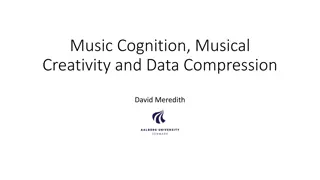

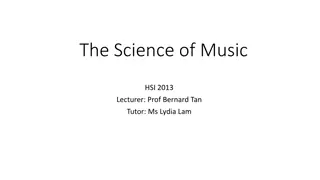





![Explore the Exciting World of Live Music Through [Insert Town/City] Census!](/thumb/148894/explore-the-exciting-world-of-live-music-through-insert-town-city-census.jpg)


